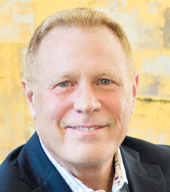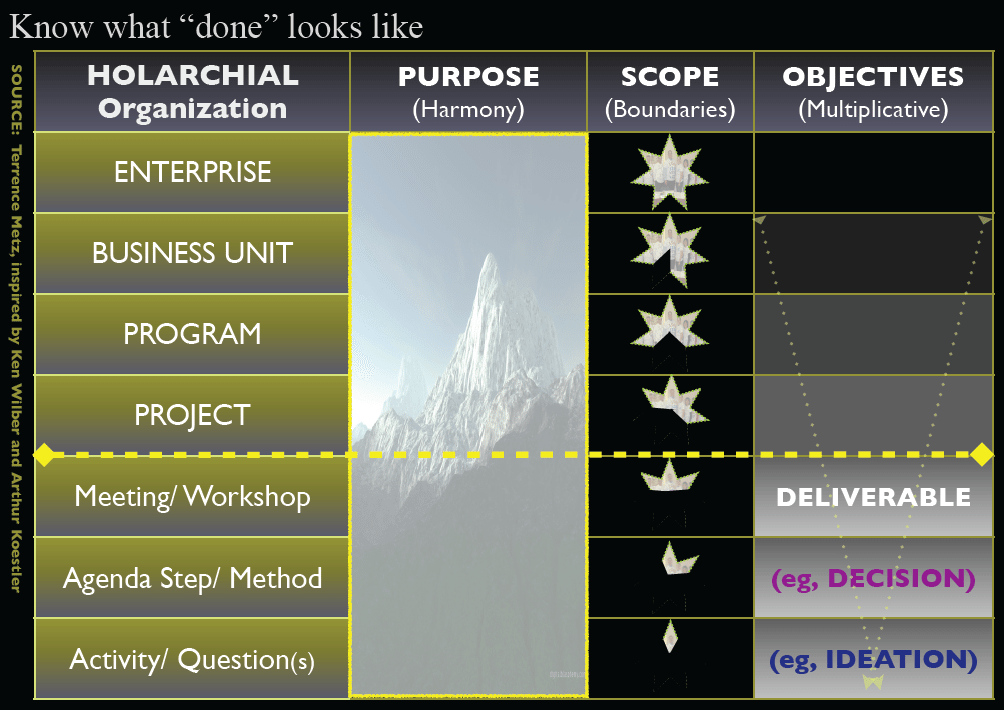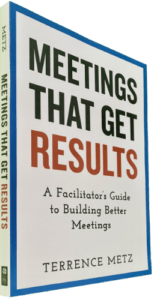Structured meetings and workshops positively impact organizations and stakeholders–even permeating cultures. Here are a few straightforward benefits of facilitation training that support structured meetings.
Business wisdom demands the application of knowledge, stuff that is ‘in−formation’ (not static). Compound the dynamism of information with the challenge of organizing a group of people, where nobody is smarter than everybody. Groups of people fail (or operate at sub-optimal levels) either because they don’t care, don’t have the talent, or don’t know how. Meetings and workshops with structure (aka interactive design❖) have always been stressed by MGRUSH. Structured facilitation training instructs HOW TO get a group of people to focus on the right question (topicality) at the right time (sequencing).
Structured facilitation training largely teaches you how to think by affecting your greatest power, the power of choice. From choosing which foot to place on the floor first, after rising in the morning, to what to wear when retiring for the evening, each day presents itself with thousands of choices. Without structure, groups are not naturally capable of focusing on the same thing, at the same time. Their choices become confused, chaotic, and sometimes catastrophic. Structured facilitation training is the process of making it easier for people to be more effective in leading groups, teams, meetings, and workshops. It includes three primary components: leadership, facilitation, and methodology.
Three Aspects of Structured Facilitation Training
The structure provides a method for transforming the abstract (thoughts) into the concrete (products). In elementary school, we learned about the WHY, WHAT, and HOW. In professional group environments, they equate to:
- Leadership [Why we are doing something],
- Facilitation [What you can do to be more effective], and
- Meeting Design [How do you lead a group from the Introduction to the Wrap].
Differences Between Structured Facilitation and “Kum-bah-yah”
The differences between structured and unstructured facilitation training begin with different deliverables. The structured world seeks outputs such as product requirements or priorities resulting from root cause analysis. The unstructured world seeks outcomes such as community awareness or peace in the Middle East.
With structured facilitation, arguments can be resolved by appealing to the objectives within the structural holarchy. The unstructured world depends on building trust and increasing awareness but has no surefire method for driving consensus. The structured world reminds us that all arguments may be resolved by appealing to enterprise objectives. The unstructured world does not necessarily share any common purpose, scope, or objectives to resolve disagreements.
Structured Facilitation Training Includes
Meetings capture a huge investment of time. Unproductive meetings affect P & L, morale, and the potential growth of your biggest asset, your people. As frequent and important as we attend meetings, little (if any) structured training has been provided to help us become better meeting participants, and more importantly, effective meeting leaders. Creating highly effective meetings depends on improving three areas of your behavioral skills, namely:
WHY —
Leadership training ensures that we begin with the end in mind. WHY do we meet equates with what DONE looks like? The best facilitators in the world will fail miserably if they don’t know where they are going. The worst facilitators can still succeed when the deliverable is clear and has an impact on the quality of life of their meeting participants.
WHAT —
Once it has been made clear where we are going, facilitation skills make it easier to know WHAT to do to ensure a successful meeting. Unfortunately, we have developed poor muscle memory over the years. Some behaviors need to be ‘unlearned’ before new behaviors are embraced. The only way to change such behaviors is through practice and immersion. Talking heads (i.e., the instructor’s lips are moving) won’t do it. Only active participation and practice will work at instilling effective and facilitative behaviors.
HOW —
Even a great facilitator who knows where they are going (i.e., What DONE looks like) still needs help. They need to know HOW they are going to get there. How will they lead a group of people from the meeting Introduction to the Wrap? While the best methodology or approach (i.e., Agenda) has more than one right answer, there is one wrong answer — if the meeting leader does not know HOW they are going to do it.
Practical Benefits of Structured Facilitation Training
- Analysis of business requirements: policies (WHY), rules (WHAT), and procedures (HOW)
- Application environments such as AGILE, Design Sprint, DMAIC, JAD, Kaizen, Kanban, Lean, LeSS, RUP, SAFe, SAP, Scrum, SDLC (waterfall), SOA, and XP
- Business agility, architecture, holistic decision support, product development, process improvement, and program alignment
- Popular deliverables include gap analysis, planning of all sorts, prioritization with levels of increasing complexity, and team and project charters
- Project and portfolio management approaches that demand consensus-based prioritization
- Work products like Daily Stand-ups, Kick-offs, Innovation and Creativity Sessions, Logical Models, Look-backs, Product Backlogs, QFD, Retrospectives, Reviews, Root Cause Analysis, SIPOC, Stand-ups, Use-Cases, and User Stories
Help Yourself to Some Additional Revenue Too
Because innovation drives profit, most people have ignored structure to secure breakthrough ideas. Understand why listening to the voice of the customer makes economic sense.
The poor evaluation of ideas represents the number one cause of failure for newly introduced products. Frequently customers either don’t need the new product (i.e., technology push) or the product does not work as expected. Structured facilitation improves the quality of evaluation and decision-making, ensuring that the best concepts become commercialized.
Focus groups stress qualitative aspects and may not effectively represent the market at large. Offline research tends to be overly quantitative and sterile, frequently subject to close-ended questions/ answers when conditional knowledge may be more important to informed decisions. While one-on-one interviews afford deep probes, they confine the knowledge to what already exists; i.e., they stay “in the box”.
Surveys help track results but lack the ability to provide leading indications of unmet needs and unexplored issues. Web-based discussions drive further but do not support solid decision-making principles. Concept testing provides qualitative feedback but lacks the quantitative rigor needed to support decisions. Conjoint analysis, also known as “Com-Pair” (and other terms), supports decision-making but does not help generate new ideas or options.
Structured Workshops Integrate the Best of All Methods
Structured workshops generate breakthrough ideas, create strategies, and ensure alignment with more customers. Group dynamics stimulate, leading to higher quality ideas and decisions. However, without solid facilitation, dominant personalities may introduce bias. Starting with customer pain points and leveraging the input from other methods mentioned above, a collaborative approach will always generate higher quality decisions than those made in a vacuum or subjected to seen and unseen biases.
Facilitation training prepares you to challenge with reflexive questioning, the “pregnant pause”, and other tips to secure evidence and support. Nobody is smarter than everybody, especially in the hands of a professional facilitator.
[1]Wisdom To Inspire
______
Don’t ruin your career by hosting bad meetings. Sign up for a workshop or send this to someone who should. MGRUSH workshops focus on meeting design and practice. Each person practices tools, methods, and activities daily during the week. Therefore, while some call this immersion, we call it the road to building high-value facilitation skills.
Our workshops also provide a superb way to earn up to 40 SEUs from the Scrum Alliance, 40 CDUs from IIBA, 40 Continuous Learning Points (CLPs) based on Federal Acquisition Certification Continuous Professional Learning Requirements using Training and Education activities, 40 Professional Development Units (PDUs) from SAVE International, as well as 4.0 CEUs for other professions. (See workshop and Reference Manual descriptions for details.)
Want a free 10-minute break timer? Sign up for our once-monthly newsletter HERE and receive a free timer along with four other of our favorite facilitation tools.
______
With Bookmarks no longer a feature in WordPress, we need to append the following for your benefit and reference
- 20 Prioritization Techniques = https://foldingburritos.com/product-prioritization-techniques/
- Creativity Techniques = https://www.mycoted.com/Category:Creativity_Techniques
- Facilitation Training Calendar = https://mgrush.com/public-facilitation-training-calendar/
- Liberating Structures = http://www.liberatingstructures.com/ls-menu
- Management Methods = https://www.valuebasedmanagement.net
- Newseum = https://www.freedomforum.org/todaysfrontpages/
- People Search = https://pudding.cool/2019/05/people-map/
- Project Gutenberg = http://www.gutenberg.org/wiki/Main_Page
- Scrum Events Agendas = https://mgrush.com/blog/scrum-facilitation/
- Speed test = https://www.speedtest.net/result/8715401342
- Teleconference call = https://youtu.be/DYu_bGbZiiQ
- The Size of Space = https://neal.fun/size-of-space/
- Thiagi/ 400 ready-to-use training games = http://thiagi.net/archive/www/games.html
- Visualization methods = http://www.visual-literacy.org/periodic_table/periodic_table.html#
- Walking Gorilla = https://youtu.be/vJG698U2Mvo

Terrence Metz, president of MG RUSH Facilitation Training, was just 22-years-old and working as a Sales Engineer at Honeywell when he recognized a widespread problem—most meetings were ineffective and poorly led, wasting both time and company resources. However, he also observed meetings that worked. What set them apart? A well-prepared leader who structured the session to ensure participants contributed meaningfully and achieved clear outcomes.
Throughout his career, Metz, who earned an MBA from Kellogg (Northwestern University) experienced and also trained in various facilitation techniques. In 2004, he purchased MG RUSH where he shifted his focus toward improving established meeting designs and building a curriculum that would teach others how to lead, facilitate, and structure meetings that drive results. His expertise in training world-class facilitators led to the 2020 publication of Meetings That Get Results: A Guide to Building Better Meetings, a comprehensive resource on effectively building consensus.
Grounded in the principle that “nobody is smarter than everybody,” the book details the why, what, and how of building consensus when making decisions, planning, and solving problems. Along with a Participant’s Guide and supplemental workshops, it supports learning from foundational awareness to professional certification.
Metz’s first book, Change or Die: A Business Process Improvement Manual, tackled the challenges of process optimization. His upcoming book, Catalyst: Facilitating Innovation, focuses on meetings and workshops that don’t simply end when time runs out but conclude with actionable next steps and clear assignments—ensuring progress beyond discussions and ideas.





